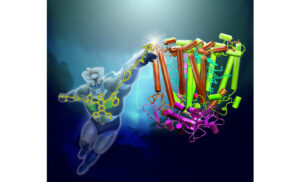 Building artificial photosynthetic molecular machines capable of exploiting solar energy for photocatalysis and electrical energy production has attracted considerable interest in recent years. The studies aim to mimic the main functions of a natural photosynthetic apparatus: harvesting light, converting it into a charge-separated state, and using this state to drive redox reactions such as water splitting.
Building artificial photosynthetic molecular machines capable of exploiting solar energy for photocatalysis and electrical energy production has attracted considerable interest in recent years. The studies aim to mimic the main functions of a natural photosynthetic apparatus: harvesting light, converting it into a charge-separated state, and using this state to drive redox reactions such as water splitting.
Photosynthetic organisms share a common functional organization of the protein complexes that form their photo- synthetic apparatus. Pigment–protein complexes (the light harvesting complexes) act as antenna, collecting solar light and funneling it to a central photochemical core (the reaction center) where this energy is converted into an electron-hole pair that is eventually used for fueling the metabolism of the organism.
In this research line we propose the concept of tailored organic fluorophores as molecular antennas, an approach which offers considerable advantages: the molecular diversity of organic compounds enables very fine tuning of spectroscopic and electronic properties, as well as control of molecular shape and flexibility. This reduces the impact of the artificial antenna on the RC structure and function. Moreover, the chemistry of bioconjugation can affix the fluorophore to selected amino acid residues. We have designed and synthesized a hybrid system combining a bacterial RC with different tailored molecular fluorophores, successfully enhancing the performances of the native protein both with single wavelength excitation and with broad-band visible illumination.
Main publications:
- Milano, F., Tangorra, R. R., Hassan Omar, O., Ragni, R., Operamolla, A., Agostiano, A., … Trotta, M. (2012). Enhancing the Light Harvesting Capability of a Photosynthetic Reaction Center by a Tailored Molecular Fluorophore. Angewandte Chemie, 124(44), 11181–11185. doi.org/10.1002/ange.201203404
- Belviso, B. D., Tangorra, R. R., Milano, F., Hassan Omar, O., La Gatta, S., Ragni, R., … Trotta, M. (2016). Crystallographic analysis of the photosynthetic reaction center from Rhodobacter sphaeroides bioconjugated with an artificial antenna. In MRS Advances (Vol. 1). doi.org/10.1557/adv.2016.10
- Hassan Omar, O., La Gatta, S., Tangorra, R. R., Milano, F., Ragni, R., Operamolla, A., … Farinola, G. M. (2016). Synthetic Antenna Functioning As Light Harvester in the Whole Visible Region for Enhanced Hybrid Photosynthetic Reaction Centers. Bioconjugate Chemistry, 27(7), 1614–1623. https://doi.org/10.1021/acs.bioconjchem.6b00175
- Simona la Gatta, Francesco Milano, Gianluca M. Farinola, Angela Agostiano, Mariangela Di Donato, Andrea Lapini, Paolo Foggi, Massimo Trotta and Roberta Ragni. Heptamethyne cyanine dyes as highly efficient synthetic antennas for photosynthetic Reaction Center: from chemical design to ultrafast energy transfer investigation of the hybrid system, In preparation
